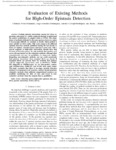Evaluation of Existing Methods for High-Order Epistasis Detection

Use este enlace para citar
http://hdl.handle.net/2183/27617
A non ser que se indique outra cousa, a licenza do ítem descríbese como Atribución 4.0 Internacional (CC BY 4.0)
Coleccións
- GI-GAC - Artigos [192]
Metadatos
Mostrar o rexistro completo do ítemTítulo
Evaluation of Existing Methods for High-Order Epistasis DetectionAutor(es)
Data
2020-10-15Cita bibliográfica
C. Ponte-Fernandez, J. Gonzalez-Dominguez, A. Carvajal-Rodriguez and M. J. Martin, "Evaluation of Existing Methods for High-Order Epistasis Detection," in IEEE/ACM Transactions on Computational Biology and Bioinformatics, doi: 10.1109/TCBB.2020.3030312.
Resumo
[Abstract]
Finding epistatic interactions among loci when expressing a phenotype is a widely employed strategy to understand the genetic architecture of complex traits in GWAS. The abundance of methods dedicated to the same purpose, however, makes it increasingly difficult for scientists to decide which method is more suitable for their studies. This work compares the different epistasis detection methods published during the last decade in terms of runtime, detection power and type I error rate, with a special emphasis on high-order interactions. Results show that in terms of detection power, the only methods that perform well across all experiments are the exhaustive methods, although their computational cost may be prohibitive in large-scale studies. Regarding non-exhaustive methods, not one could consistently find epistasis interactions when marginal effects are absent. If marginal effects are present, there are methods that perform well for high-order interactions, such as BADTrees, FDHE-IW, SingleMI or SNPHarvester. As for false-positive control, only SNPHarvester, FDHE-IW and DCHE show good results. The study concludes that there is no single epistasis detection method to recommend in all scenarios. Authors should prioritize exhaustive methods when sufficient computational resources are available considering the data set size, and resort to non-exhaustive methods when the analysis time is prohibitive.
Palabras chave
Genetics
Filtering
C++ languages
Particle swarm optimization
Matlab
Clustering algorithms
Detection power
High-order epistasis
False positives
Genetic interaction
Review
Survey
Filtering
C++ languages
Particle swarm optimization
Matlab
Clustering algorithms
Detection power
High-order epistasis
False positives
Genetic interaction
Review
Survey
Versión do editor
Dereitos
Atribución 4.0 Internacional (CC BY 4.0)
ISSN
1557-9964






